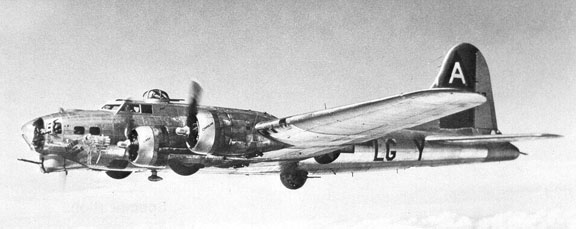U.S.A.A.F. RESOURCE CENTER > BOMBERS > FLYING FORTRESS > PREVIOUS PAGE

The B-17 was primarily employed by the United States Army Air Forces (USAAF) in the daylight precision strategic bombing campaign of World War II against German industrial and military targets. The United States Eighth Air Force, based at many airfields in central and southern England, and the Fifteenth Air Force, based in Italy, complemented the RAF Bomber Command's nighttime area bombing in the Combined Bomber Offensive to help secure air superiority over the cities, factories and battlefields of Western Europe in preparation for the invasion of France in 1944. The B-17 also participated to a lesser extent in the War in the Pacific, early in World War II, where it conducted raids against Japanese shipping and airfields.
From its prewar inception, the USAAC (by June of 1941, the USAAF) promoted the aircraft as a strategic weapon; it was a fast, high-flying, long-range bomber that was able to defend itself, carried a very good bomb load and was able to return home despite extensive battle damage. Its reputation quickly took on mythic proportions, and widely circulated stories and photos of notable numbers and examples of B-17s surviving battle damage increased its iconic status. With a service ceiling greater than any of its Allied contemporaries, the B-17 established itself as an effective weapons system, dropping more bombs than any other U.S. aircraft in World War II. Of the 1.5 million tonnes of bombs dropped on Germany and its occupied territories by U.S. aircraft, 640,000 tonnes were dropped from B-17s. In addition to its role as a bomber, the B-17 was also employed as a transport, antisubmarine warfare platform, drone controller, and search-and-rescue aircraft.
|
– Design/Construction — Sperry Ball Turret – Operational History – Postwar Usage – Captured/Interned |
– Specifications – Variants – Image Gallery – Survivors |
Sources:
Gunston, Bill - The Encyclodepia of the Worlds Combat aircraft, 1976, Chartwell Books, Inc., New York
Wikipedia
U.S.A.A.F. RESOURCE CENTER > BOMBERS > FLYING FORTRESS > PREVIOUS PAGE
